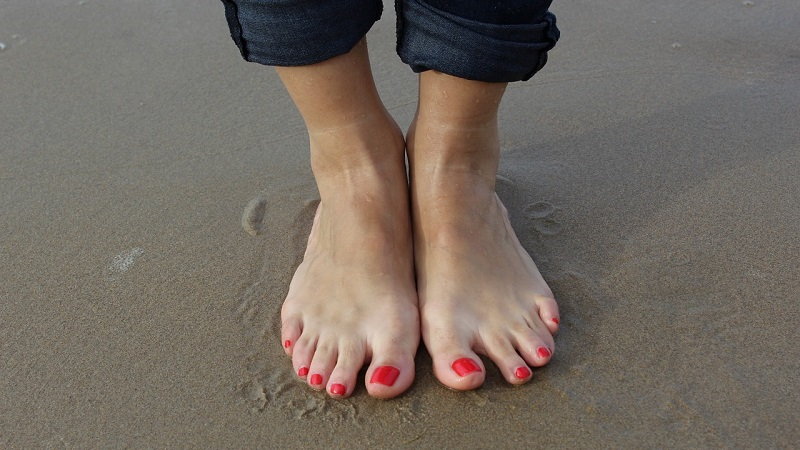Summer is wedding season, and beach season, and vacation season, and camping season, and well, the list goes on! When it comes to your feet, summer means slipping into a range of different shoes from high heels to sandals to water shoes to sneakers as well as showing off your foot jewellery.
Have burning questions about best foot care during the warm summer months? From hot sand to high heels, we’re covering all the bases.

Can hot sand burn the bottom of my feet?
While the sand in the morning can be cool and denser, any avid beach goer knows how quickly it can heat up, especially on southern Florida beaches down to the Caribbean. The beating of the sun might increase the temperature of sand to a blazing 120 degrees Fahrenheit – this can cause blisters and burns on the bottom of your feet if you are not wearing proper footwear.
First degree burns are typically more superficial causing a redness of the affected area, no blisters, and will heal on its own. A second degree burn, however, will have some partial destruction of the skin layer with painful blistering, redness, and a lasting burning sensation.
The longer you remain in contact with a heat source, the further the extent of your burn injury will be, thus standing or walking on hot sand while barefoot will be more dangerous the longer you do it. Keep an eye out for “hot sand” warnings on signs at the entrance of the beach you visit and on the lifeguard station, and practice caution by always wearing shoes out on the beach sand.
Read also: Winter Footcare Tips
What happens if I wear wet shoes too long?
Hiking through creeks or after a rainy day can have you slogging around in wet shoes for hours. Is that bad? Let’s just say you have to be extra careful.
Prolonged soaking in wet shoes actually causes your top layer of skin to absorb all that moisture resulting in a pruning effect and making the skin more susceptible to blistering. Skin may also feel itchy or sore, and as it dries, the skin on your feet and toes may crack.
The onslaught of moisture from your wet shoes imbalances the natural oils in your feet, and after being macerated (softened by the moisture), the skin dries and can break open – this can be painful and make walking and hiking harder.
“Waterproof” shoes and hiking boots may be a good solution for you, though for many, they find that water still makes its way in, and that waterproof shoes are less likely to fully drain and dry out before another adventure compared to regular non-waterproof shoes.
Others recommend simple water shoes, like those by Teva or Chaco, which can be hiked in and have great drainage. Wear thinner wool socks when wet hiking and avoid thick cotton socks which can take on a lot more water. Also consider rubbing a salve or ointment that creates a waterproof barrier on your feet before you put on socks and shoes for your wet hike.
Is wearing high heels bad for you?
Dressing up for another wedding, work fundraiser, or nice dinner on vacation? Women can especially find themselves donning narrow, uncomfortable heels more than ever during the summer because of special events and occasions. How bad are high heels for you really?
To begin with, high heels are the most “unnatural” shoe; that is, they require body mechanics which humans simply aren’t evolved for. High heels bend your ankle forward, alter the sway of your hips, restrict blood flow to important parts of the feet, and pinch your toes together in a narrow point.
Not only can this cause foot and leg pain, but knee, hip, and back aches as well. A 2016 study from Stanford University found that the increased stress put on knees when high heels were worn also contributed to an increased risk of knee osteoarthritis. Prolonged use of high heels can also cause bone deformities in the foot including bunions, bone spurs, and hammertoe.
If you’re racking up the wedding invites this summer and are worried about having to slip on another pair of high heels, consider wearing flats or kitten heels (1 inch or less) instead. Or make sure to bring a pair of flat shoes or sandals along with you to change into if your feet hurt, and especially for hitting the dance floor.
I want to exercise this summer, but foot pain is holding me back. What can I do?
If you’re experiencing foot pain, you are not alone. Both older adults as well as high heel wearers, and avid athletes, especially runners, may put up with foot and leg pain regularly and never see a doctor about it. When it starts preventing you from staying active or doing the things you love, however, it is definitely time to seek help.
A doctor or podiatrist can help diagnose your foot pain and strategise an effective treatment plan with you. Depending on your strain or injury, like arch pain from plantar fasciitis, a doctor may recommend orthotic inserts or an arch support strap.
For chronic heel pain, a doctor may prescribe calf stretches, foot exercises, and updating running shoes. For irritated skin from deformities like bunions or hammer toe, different shoes, cushion inserts, and protective dressings may be suggested to help alleviate pain.
Don’t forget proper foot care this summer! You’ll find yourself outside more than usual and wearing sandals which can mean dirtier feet and more opportunities to injure them. Wash and dry feet thoroughly every day, and apply moisturizer to keep skin supple and prevent it from drying out.
Avoid walking on super hot sand and pavement, and when you’re planning on covering a lot of mileage, i.e. attending a summer festival or hiking, wear proper footwear that fits, supports good body movements, and keeps your feet dry.




